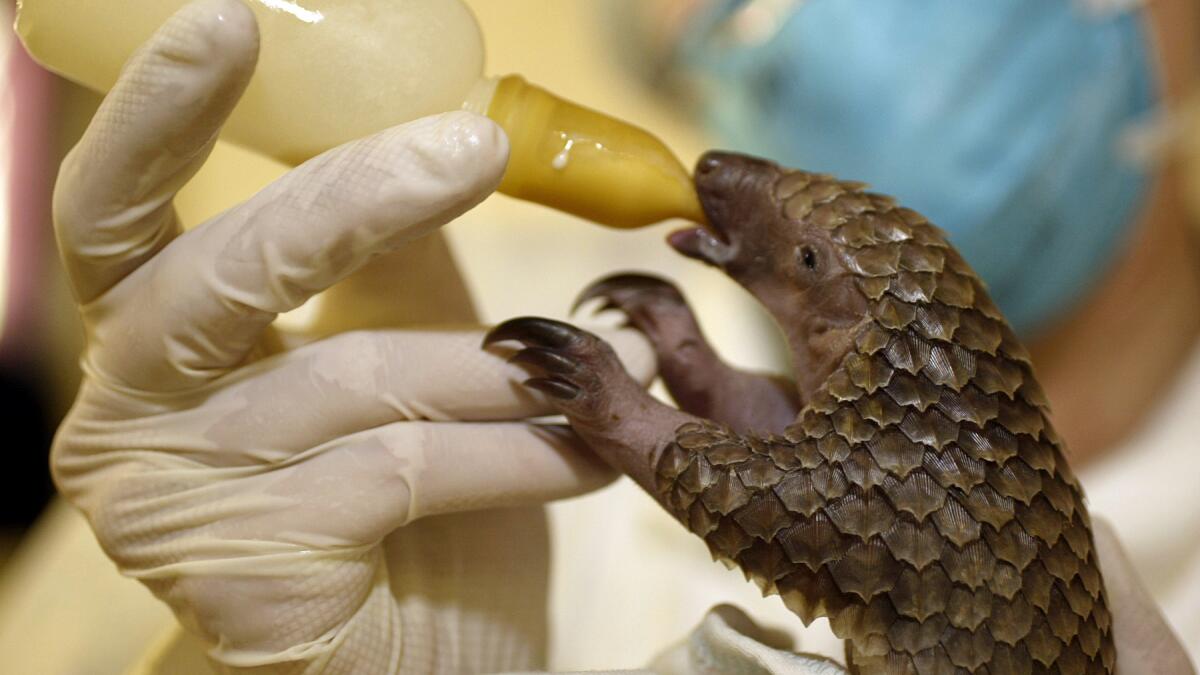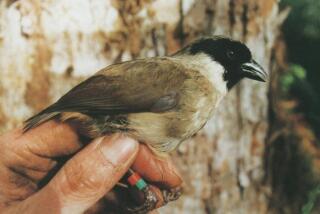Meet the pangolin, the most poached mammal in the world

Meet the pangolin, the most-poached and illegally trafficked mammal in the world.
As the congress of the International Union for Conservation of Nature and Natural Resources gets underway Thursday in Hawaii, environmental policymakers and conservation experts will discuss managing the environment, protecting wildlife and how best to chart the direction of conservation efforts.
High on the agenda and among the most anticipated species up for discussion is the pangolin.
A largely unknown creature, the pangolin holds the undesirable title of being the most-poached and illegally trafficked mammal in the world. Scientists estimate that more than 1 million have been killed in the last decade.
So what exactly is a pangolin?
They are burrowing mammals covered in protective overlapping scales made of keratin, the same protein that forms human hair and fingernails, according to SavePangolins.org, an online group that raises global awareness of pangolins and the efforts to save them from extinction. They are solitary and nocturnal, and very little research has been conducted about their daily lives.
Found in Asia and sub-Saharan Africa, there are eight species of pangolin, and they vary in weight and color, ranging from yellowish brown to dark brown. They feed on ants and termites excavated from the earth using their extraordinarily long and sticky tongues and elongated nails.
They often are referred to as being scaly anteaters, but they are not part of the anteater family, said Jeff Flocken, North American director for the International Fund for Animal Welfare. “They have no relatives on the planet.”
Why are pangolins prized, and how great is the threat to them?
Pangolins are commercially poached because their scales can be used in traditional medicine, as fashion accessories and eaten as a high-end cuisine.
“The threat is significant and escalating,” said Flocken, who also is a member of the IUCN Pangolin Specialist Group.
It’s impossible to know how many pangolins exist, environmentalists have said, but “due to the high demand for consumption, they are disappearing,” Flocken said.
Pangolins most likely have vanished in China and are fast disappearing from Vietnam, Thailand and other parts of Southeast Asia, wildlife experts said. In Africa, illegal trafficking is rapidly depleting their population.
The demand for pangolin in Asia has grown with the rise of the middle class and increasing affluence in countries such as China, experts said.
“Anything that is really rare and exotic is desirable. It’s a symbol of wealth,” said Crawford Allan, senior director of the wildlife trade monitoring network TRAFFIC at World Wildlife Fund. “Anything seen to be delicacy is now in vogue.”
Who are the culprits?
The poachers range from independent trappers to crime syndicates, and their level of destruction is staggering, wildlife experts said.
There have been 11,000 pangolins trafficked in the past three months, according to data collected by the IUCN. For example, in June, authorities in Hong Kong confiscated 4.4 tons of pangolin scales hidden in cargo labeled “sliced plastics” from Cameroon.
The haul was estimated to involve between 1,100 and 6,600 African pangolins, and was valued at around $1.25 million on the black market, according to IUCN Director General Inger Andersen. It was one of the largest seizures of pangolin scales, Andersen said in a statement in June.
In July, Hong Kong officials seized more than 10 tons of pangolin scales in shipping containers coming from Nigeria and Ghana. And in August, Indonesian authorities confiscated more than 650 pangolin bodies hidden in freezers at a home on the island of Java, according to media reports.
Lisa Hywood, founder of the Tikki Hywood Trust, a Zimbabwe-based conservation nonprofit that rescues, rehabilitates and releases pangolins, said her group had rescued 97 pangolins in the past three years. Five years ago, the rescue rate was maybe one a year, she said.
Last year, 84 pangolin poachers were arrested in Zimbabwe; of those, 47 were convicted and sentenced to nine years in prison, Hywood said.
Though not a significant consumer of pangolin products, the U.S. is not immune to illicit trafficking of the animal.
Statistics confirmed by the U.S. Fish and Wildlife Service show that 30,000 products made from pangolins were seized coming into the U.S. in the last decade.
An agency spokesperson said the products were predominantly “manufactured medicinal items that are labeled to contain pangolin as an ingredient,” but the import of such products is illegal without a permit.
“If this level of industrial-scale illegal extraction and trafficking does not abate, pangolins could pretty soon be on the brink of extinction,” said Allan, the wildlife trafficking and trade expert.
So what’s being done to protect pangolins?
Pangolins are listed under Appendix II of the Convention on International Trade in Endangered Species of Wild Fauna and Flora, which includes “species not necessarily threatened with extinction,” but may become so without trade restrictions.
Many states in Africa and Asia have laws prohibiting the capture and trade of pangolins, but the laws are not always enforced.
On Wednesday, a coalition of conservation groups passed a motion calling for all eight pangolin species to receive the most stringent international protection available, a move that essentially would ban all international commercial trade and ramp up enforcement.
The motion also appeals for more support and understanding of the pangolin. A decision is expected later this month in Johannesburg, South Africa.
Conservation groups also have submitted a technical science and trade petition to Fish and Wildlife requesting that all species of pangolins be listed as endangered under the U.S. Endangered Species Act. So far, only one species, the Temminck’s ground pangolin of Africa, is on that list.
The U.S. Fish and Wildlife Service also has launched the Mentor-Progress on Pangolins fellowship program. Based in Yaoundé, Cameroon, it is training a team of early-career Central African and Asian conservation practitioners to champion the conservation of pangolins in Central Africa.
“You can pour as much money as you want into enforcement, but so long as the demand is still there and the consumer market is there and the price is so high, the criminal networks will always find a way to poach animals and get these stolen gems of nature to the black market,” said Allan, the wildlife specialist.

Where can pangolins been seen in the U.S.?
Pangolins do not typically fare well in captivity, conservationists said.
The San Diego Zoo is the only accredited zoo facility in the United States with a pangolin exhibit, according to zoo officials.
As Rick Schwartz, an ambassador for San Diego Zoo Global recalls, a crime in 2007 involving an illegal shipment of pangolins led to the zoo being entrusted by the U.S. Fish and Wildlife Service to care for eight pangolins.
“Some of them were in such bad shape that many passed away within the first few days,” Schwartz said. “We were able to keep one male and one female alive.”
The female died around five years ago. That left the zoo with just the male, a white-bellied tree pangolin they named Baba.
Zoo officials don’t know his age, but he weighs around 5.5 pounds. They created a special habitat for him, mimicking the warm and humid environment of the African equatorial rainforest, where his species is found.
Nutritionists make a specially researched high-fiber blend of ground-up insectivore pellets and liquid for Baba, who officials say has been a popular attraction at the zoo.
“We have people who travel to the zoo just to see it,” Schwartz said. “Most people don’t even think they’re real.”
For more on global development news follow me @AMSimmons1 on Twitter
More to Read
Sign up for Essential California
The most important California stories and recommendations in your inbox every morning.
You may occasionally receive promotional content from the Los Angeles Times.











